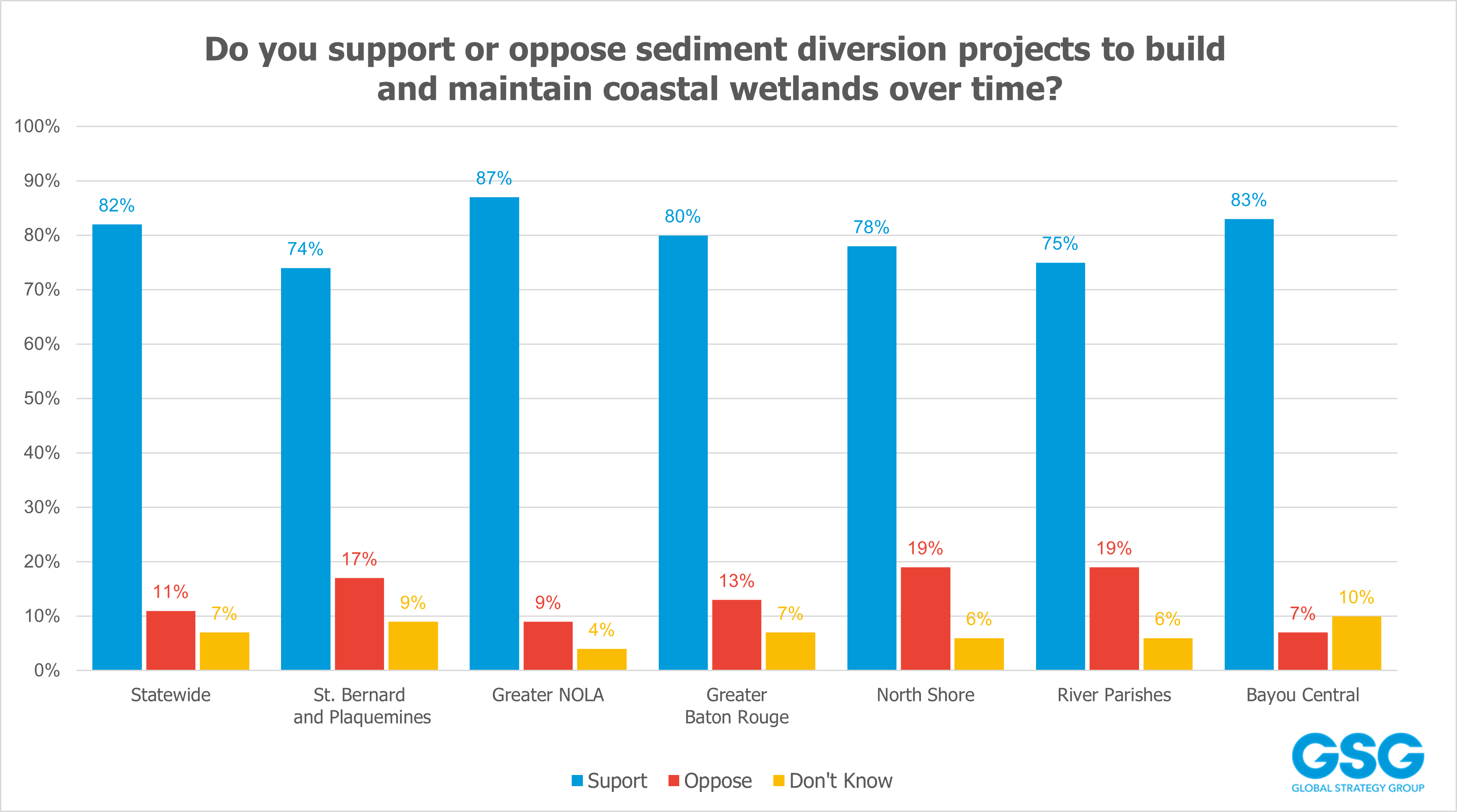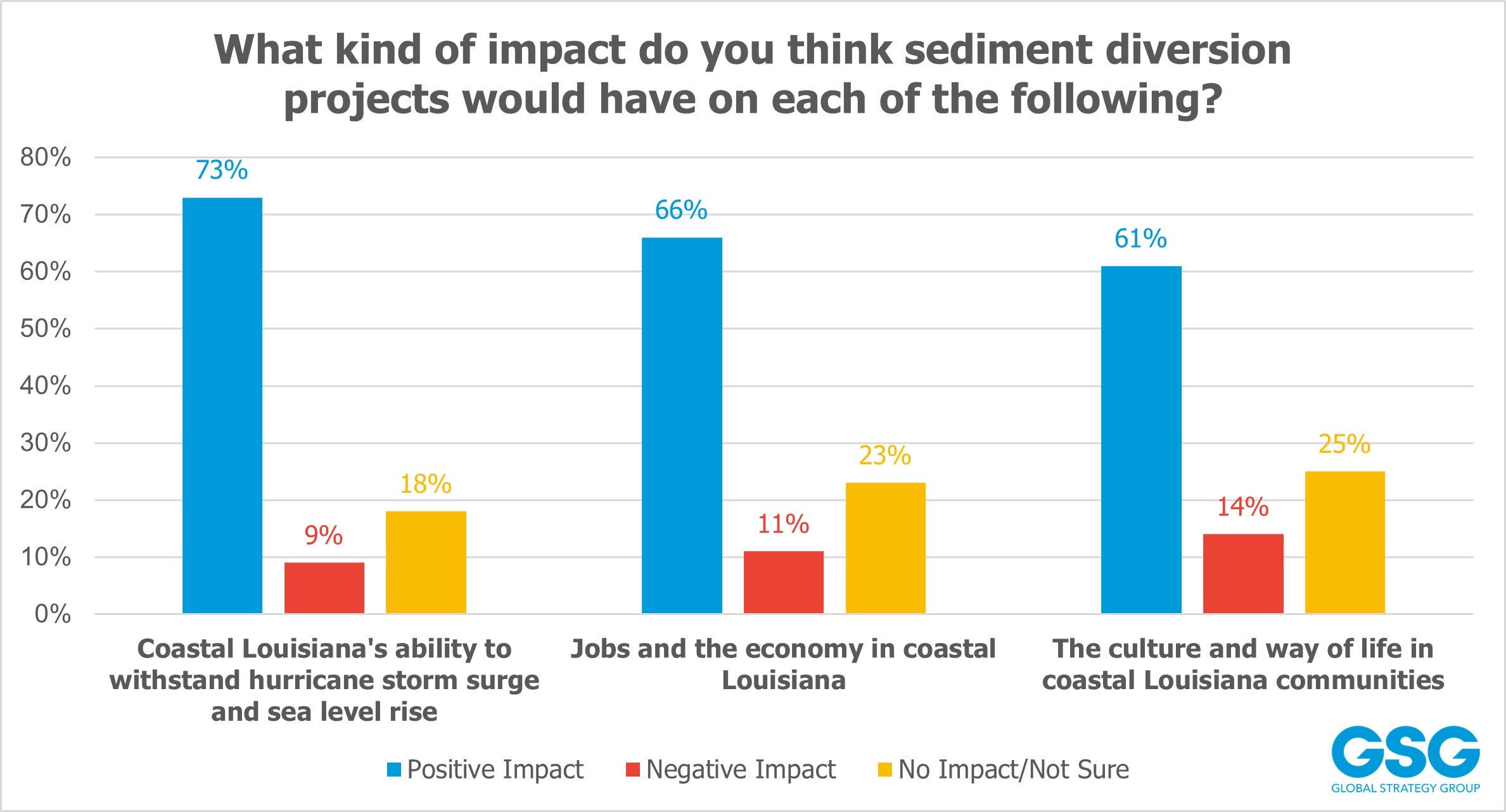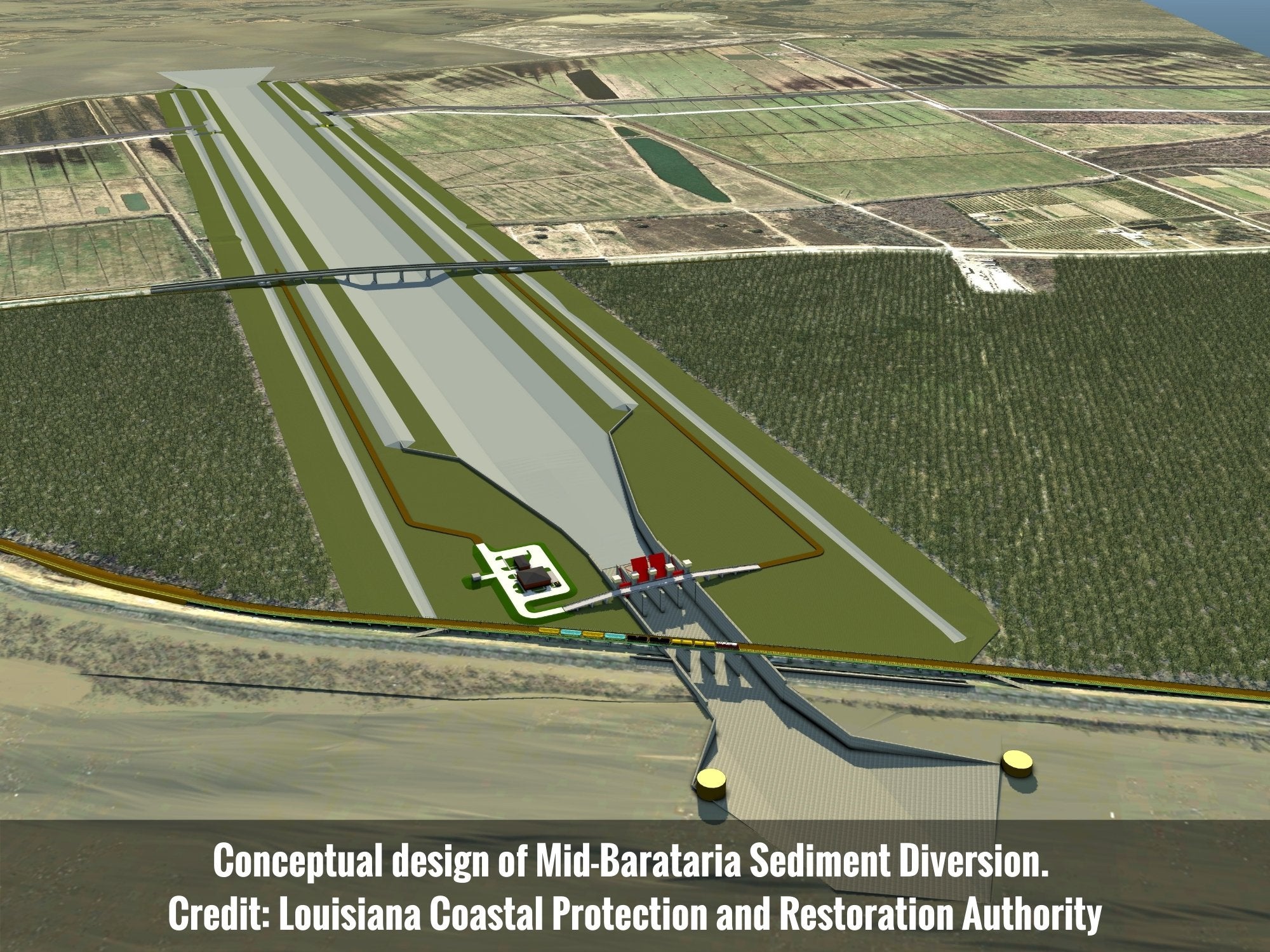The Mid-Barataria Sediment Diversion: Fact vs. Fiction
Our state has lost more than 2,000 square miles of its coast in less than a century, and it’s losing more by the minute. It’s a massive and complicated problem, with a number of contributing factors. But one of the biggest is the artificial restricting of the Mississippi River within levees, choking off the regular introduction of nutrient-rich sediment into our coastal wetlands.
The construction of levees, which began more than 300 years ago, was the solution to river flooding, but it came with catastrophic long-term consequences. Paradoxically, the solution to flooding from the river made all of south Louisiana more vulnerable to flooding from hurricanes and storm surge. Managing the problem is fundamental to coastal restoration; without it, we are leaving our most powerful tool on the table.
That’s why the Mid-Barataria Sediment Diversion is Louisiana’s most important coastal restoration project to date. It will reconnect the river to adjacent wetlands and restore the natural balance that built south Louisiana in the first place. There are genuine concerns about potential negative impacts associated with the Mid-Barataria Sediment Diversion, and the State of Louisiana is spending hundreds of millions of dollars on mitigation. But choosing not to build the project is not a viable option if people and communities are going to continue to live and thrive across our region.
Unfortunately, a disinformation campaign designed to mobilize opposition to the project has involved cherry-picking slivers of truth and embellishing them to shape a misleading narrative about the ability of the diversion to create and sustain land; about the effects on fishing and wildlife; and about the rate at which coastal parishes will vanish into the Gulf without it.
The disingenuous attacks have found some receptive audiences. But the vast majority of Louisiana residents statewide support sediment diversions. An overwhelming majority of the residents of St. Bernard and Plaquemines parishes also support sediment diversions. The bottom line is that the people and communities of south Louisiana demand healthy wetlands, hurricane and storm surge protection and fisheries that are sustainable now and in the future — not false promises about alternatives that are too little — and too late.
Let’s take a look at some of the misinformation about the project and set the record straight.
CLAIM
The Mid-Barataria Sediment Diversion is being imposed upon residents who do not want it.
TRUTH
Residents have been included in discussions about the project from the beginning. Over the past 4 years, CPRA has held 316 meetings with elected and parish officials, members of the seafood and recreation industries, communities near the project site, and nonprofit and stakeholder groups, as well as the general public. A total of 12,000 stakeholders have participated. These meetings and outreach are ongoing, as the state works to move the project forward to restore our wetlands while also developing a stewardship and mitigation plan to address any potential impacts. Independent polling conducted in 2018 found that 79% of Louisiana residents supported sediment diversions. In Plaquemines and St. Bernard parishes, 70% of residents polled supported sediment diversions. Polling conducted this year showed even stronger support, statewide and in Plaquemines and St. Bernard.

CLAIM
Dolphins are a “canary in a coal mine” that will become “virtually extinct” because of the diversion.
TRUTH
This is a misrepresentation of what most scientists say about the Mid-Barataria Sediment Diversion. The Army Corps of Engineers’ draft Environmental Impact Statement (DEIS) indicates that the long-term health of our fisheries and wildlife, including dolphins, will likely be worse without the sediment diversion as the entire ecosystem continues to collapse from wetlands loss. That is to say, anyone genuinely concerned about dolphins should support the project, not oppose it. Clearly, gradually returning the Barataria Basin to its more traditional setting with more mixing of fresh and salt water will create challenges for species as they adapt to the resetting of habitat, and that is analyzed in the DEIS. That is why the state has already committed to investing $40 million to actively monitor and address impacts to dolphins in Louisiana’s Barataria Basin. “The Mid-Barataria diversion gives us a chance to keep Barataria Bay from disappearing rapidly. And perhaps surprisingly, most living marine resources are better off when the diversion is built compared to a future without it,” said Dr. Kim de Mutsert, assistant professor, School of Ocean Science and Engineering, University of Southern Mississippi, and one of the signers of a recent letter from 55 scientists with a combined 1,300 years of research and technical experience related to Louisiana’s coast, supporting the sediment diversion.
CLAIM
The diversion will destroy our way of life and jobs in Plaquemines Parish.
TRUTH
To the contrary, this project is essential to any long-term plans to preserve our way of life as the parish faces more intense hurricanes, unchecked land loss and sea level rise. Not only will the diversion maintain and restore thousands of acres of wetlands to provide a vital buffer for communities from increasing storm surge and tidal flooding, but it will also have a massive environmental benefit to the region. And it will create thousands of jobs. According to the project’s draft environmental impact statement, as a result of the project’s construction, regional businesses will see a $1.3 billion increase in sales, household earnings could rise by as much as $648 million, and the project will support approximately 12,400 new jobs during its construction.

CLAIM
We can “dredge” our way out of our coastal land loss crisis.
Learn more about the Mid-Barataria Sediment Diversion |
TRUTH
Dredging, or pumping sediment to create marshes and barrier islands, has long been a part of coastal restoration, and it will continue to be under the state’s plans. In fact, 18 dredging projects around Louisiana are slated for construction over just the next year, using 89.4 million cubic yards of dredged material to create or nourish nearly 14,000 acres. But it is not enough. Subsidence, more intense hurricanes and sea level rise pose serious challenges, and without sediment diversions to regularly deliver sands, silts and clays to our wetlands, our wetlands will continue to disappear at an alarming rate. If there were no action in Plaquemines Parish, 55% of the parish’s land would cease to exist within 50 years. That’s over half the parish simply gone. A 5-year plan based on dredging suggested by some opponents of the Mid-Barataria Sediment Diversion will not remotely keep up with land loss. That should be unacceptable to anyone who loves Louisiana. As CPRA wrote in its 2012 Master Plan, sustainable restoration of our coast without sediment diversions is not possible.” And according to Plaquemines Parish’s own 2010 Master Plan, sediment diversions are among the projects required to provide long-term protection to residents and communities in the parish.
CLAIM
“It’s not a freshwater diversion. It’s a polluted water diversion.”
TRUTH
The Mississippi River is cleaner than it has been in decades. More work and investments in a consistent and comprehensive manner are needed to improve the health and water quality of the river, but since the passage of the Clean Water Act and Clean Air Act, water quality in the river has improved significantly. A 2020 assessment by the Environmental Protection Agency concluded that from Baton Rouge to the Head of Passes, Mississippi River water quality was suitable for aquatic life, recreation and even drinking water. In addition, the river and its water are the basis for the estuary that supports commercial fishing interests across south Louisiana. Calling the Mid-Barataria Sediment Diversion a “polluted water diversion” is simply a scare tactic to exaggerate the threat of pollution in the river. The ongoing efforts to improve water quality in the river continue, and the National Wildlife Federation, National Audubon Society and Environmental Defense Fund, all members of Restore the Mississippi River Delta, are among the organizations working to further improve it.

CLAIM
The Mid-Barataria Sediment Diversion will destroy Louisiana’s fisheries.
TRUTH
The truth is that as a result of wetlands loss, Louisiana’s Barataria Basin is on the verge of near total collapse, threatening the existence of species like shrimp and oysters. As the diversion restores a natural balance to the estuary and builds and maintains wetlands, there will be short-term impacts to certain saltwater species. The State of Louisiana is investing millions of dollars to address these, working directly with fishers and others whose livelihoods may be negatively impacted to solicit their ideas for how to invest this money to help them adapt to these changes. Overlooked in the misinformation campaign is that the diversion is expected to benefit a number of species, including increasing the productivity of white shrimp, largemouth bass, red drum, waterfowl and more. One can simply look at parts of Louisiana where new land is already being created by sediment delivered by the Mississippi River and see lush vegetation and an abundance of wildlife. Rather than claiming untruthfully that fisheries can thrive without the reintroduction of sediment into our wetlands, we believe the fishing industry and elected officials should facilitate productive discussions about how fisheries and fishers can adapt to conditions that are changing one way or the other. Pretending that fisheries can continue along their current course is a shortsighted strategy that is removing fishers and fisheries from discussions about their future — and that threatens to leave them without one. We need our leadership focused on how best to spend the hundreds of millions of dollars available for mitigation to help Louisiana’s fisheries.
CLAIM
The Mid-Barataria sediment diversion is an experiment.
TRUTH
The Mid-Barataria Sediment Diversion is Louisiana’s most significant coastal restoration project to date, and it will restore thousands of acres of wetlands to provide a vital buffer for communities from storm surge and restore the health of the ecosystem upon which Louisiana’s “Sportsman’s Paradise” depends. For nearly half a century, a large consensus of scientists have recognized that reconnecting the Mississippi River to adjacent wetlands is the only way to maintain a sustainable future for our region and coast. In the river, Louisiana has a powerful land-building tool that coastal cities including Miami and New York lack. It is our best shot to push back against sea level rise, subsidence and hurricane storm surge, but since our state is already washing away, the sooner we put it back to work, the better. We don’t have to rely upon scientific projections to know the river can build land. The river created the land we live on today, and it absolutely continues to build land — in places where it has been reconnected to wetlands and is delivering fresh water, sediment and nutrients. Here are five spots in Plaquemines Parish alone where land is being built instead of disappearing. You can take a virtual tour or read media coverage about the newest parts of Louisiana that have formed because of connection to the Mississippi River. These areas are thriving, filled with lush vegetation and fish and with healthy oxygen levels. We urge you to visit them and see for yourself, and we can help make that happen.
Have you got questions? We have answers. Are you a member of the media interested in seeing land building in action? Let us know.
Resources:
- 55 Leading Scientists Express Overwhelming Support for Mid-Barataria Sediment Diversion
- What Are Supporters Saying About Sediment Diversions?
- The Mississippi River is Our Greatest Force for Building Land
- Claims vs. Realities: Fresh water, Nutrients and Restoring the Mississippi River Delta
- Mid-Barataria Sediment Diversion Draft Environmental Impact Statement
- Louisiana Coastal Issues Poll
